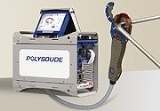
Orbital welding
Encyclopedia
Orbital welding is a specialised area of welding
whereby the arc is rotated mechanically through 360° (180 degrees in double up welding) around a static workpiece, an object such as a pipe, in a continuous process.
By using mechanised variants of the technique, certain parts of the welding process are handled by mechanical components. Note that a welder will always be monitoring and controlling the process. In an ideal situation, all welding parameters would be fully programmed before welding is started. In practice, however, the presence of variable constraints means that it is often necessary for the welder to make corrective interventions.
With automated welding, the computer-controlled welding process runs completely independently, without the need for any intervention from the operator.
(TIG) technique using non-consumable electrodes, with additional cold-wire feed where necessary. Many different types of metal can be welded; high-strength, high-temperature and corrosion-resistant steels, unalloyed and low-alloyed carbon steels, nickel alloys, titanium, copper, aluminium and associated alloys. Carried out in an inert atmosphere, this controlled technique produces results that are extremely clean, have low particle counts and are free from unwanted spatter. This enables the highest demands to be met regarding the mechanical and optical properties of a weld seam.
In order to create high quality weld seams it is essential that tube ends are carefully prepared with the edges of the workpieces being free of scale and impurities. For thinner-walled tubes up to medium diameters, a simple right-angled saw cut is often sufficient. For thicker tube walls it is necessary to prepare the edges more carefully, for example using a U-groove cross-section.
Welding
Welding is a fabrication or sculptural process that joins materials, usually metals or thermoplastics, by causing coalescence. This is often done by melting the workpieces and adding a filler material to form a pool of molten material that cools to become a strong joint, with pressure sometimes...
whereby the arc is rotated mechanically through 360° (180 degrees in double up welding) around a static workpiece, an object such as a pipe, in a continuous process.
Equipment
The main components of every orbital welding system are the power source and controller, the welding head, water cooler and, where required, a wire feed mechanism. There are a large number of factors that can have an influence on the welding result. These aspects include the arc length, magnitude and pulse frequency of the welding current, welding speed, inert shielding gas, parent material, filler material, weld preparation, and thermal conductivity. Ultimately, a high quality weld is achieved through detailed knowledge of how to precisely adjust all these parameters for each individual welding task.The welding process
It is very difficult to achieve the highest standards of quality and safety using manual welding. This is due to certain welding positions, overhead and down-hand welds for example, often leading to faulty welds due to restricted access the user has in these welding positions. In order to have complete control over the weld pool, a perfect balance must be maintained between gravitational force and surface tension at every position of the torch.By using mechanised variants of the technique, certain parts of the welding process are handled by mechanical components. Note that a welder will always be monitoring and controlling the process. In an ideal situation, all welding parameters would be fully programmed before welding is started. In practice, however, the presence of variable constraints means that it is often necessary for the welder to make corrective interventions.
With automated welding, the computer-controlled welding process runs completely independently, without the need for any intervention from the operator.
Materials
Orbital welding has almost always exclusively been carried out by the Tungsten Inert GasGas tungsten arc welding
Gas tungsten arc welding , also known as tungsten inert gas welding, is an arc welding process that uses a nonconsumable tungsten electrode to produce the weld...
(TIG) technique using non-consumable electrodes, with additional cold-wire feed where necessary. Many different types of metal can be welded; high-strength, high-temperature and corrosion-resistant steels, unalloyed and low-alloyed carbon steels, nickel alloys, titanium, copper, aluminium and associated alloys. Carried out in an inert atmosphere, this controlled technique produces results that are extremely clean, have low particle counts and are free from unwanted spatter. This enables the highest demands to be met regarding the mechanical and optical properties of a weld seam.
Tube diameters
Due to the precision of orbital TIG welding, even the smallest standard tube diameters from 1.6 millimetres can be processed. On a larger scale, pipes with diameters up to 170mm and walls up to 3.5mm thick can be joined using closed chamber weld heads. These weld heads allow the torch to be positioned very precisely and ensure that the pipe is held securely. The inert gas atmosphere in the closed chamber prevents heat from tinting, even with the most sensitive of materials. For tube diameters between 8 and 275mm, it is possible to use more manageable open welding heads. A flexible hose system is used to supply the welding head with power, inert gas, cooling water and filler wire where required. The need for filler wire during the welding process depends on the type of welding task; thicker tube walls and difficult-to-control parent materials require the use of additional material, whereas thin-walled tubes can be welded without extra wire.In order to create high quality weld seams it is essential that tube ends are carefully prepared with the edges of the workpieces being free of scale and impurities. For thinner-walled tubes up to medium diameters, a simple right-angled saw cut is often sufficient. For thicker tube walls it is necessary to prepare the edges more carefully, for example using a U-groove cross-section.

